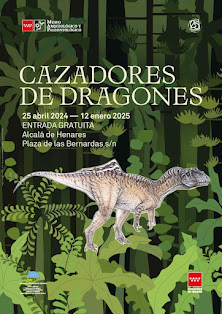Continuamos con los trabajos presentados en el último Annual Meeting de la EAVP por miembros del Grupo de Biología Evolutiva de la UNED, nos centramos en la comunicación sobre los dinosaurios terópodos de Morella (Castelón, España). En el congreso se presentó el estudio de un conjunto de restos postcraneales, que incluyen una vértebra cervical, fragmentos de dos fémures y una tibia parcial, recogidos en niveles del Barremiense superior de la Formación Arcillas de Morella y que presentan una combinación de características compatible con los espinosáuridos barionicinos.
El resumen es el siguiente:
Megalosauroid theropods are a relatively diverse clade of basal tetanurans with a worldwide distribution. The clade includes piatnitkysaurids, megalosaurids and spinosaurids. The latter are especially well-represented in Cretaceous strata of Africa, South America, and Asia, but also in Europe, mainly in England, Portugal and Spain. Here, new postcranial remains of spinosaurid dinosaurs from the upper Barremian Arcillas de Morella Formation of Spain are described. These elements correspond to a posterior cervical vertebra, a right femur, a proximal fragment of a right femur, and a partial left tibia collected in three sites within the Mas de la Parreta Quarry at Morella (Castellón province, Spain). These remains present a combination of characters compatible with the clade of spinosaurids Baryonychinae, including the cervical vertebra with neural spine low and transversely thin and elongated zygapophyses and epipophyses. Comparison with elements assigned to Baryonyx indicates some differences between the remains from Morella and those of this genus described in the Lower Cretaceous of England, including the less ventral extension of the lateral femoral condyle relative to the medial one and the much less anteroposteriorly compressed femoral proximal end. Based on some identified differences, especially evident on the femora, the specimens from Morella can be confidently referred to a baryonychine distinct from Baryonyx. These new specimens support the previously proposed hypothesis on the presence of baryonychines in the eastern Spain and add information for the knowledge of the diversity and distribution of this clade in the Lower Cretaceous of the Iberian Peninsula.
-----
Más información:





























No hay comentarios:
Publicar un comentario